1994 BUICK REGAL air conditioning
[x] Cancel search: air conditioningPage 14 of 308
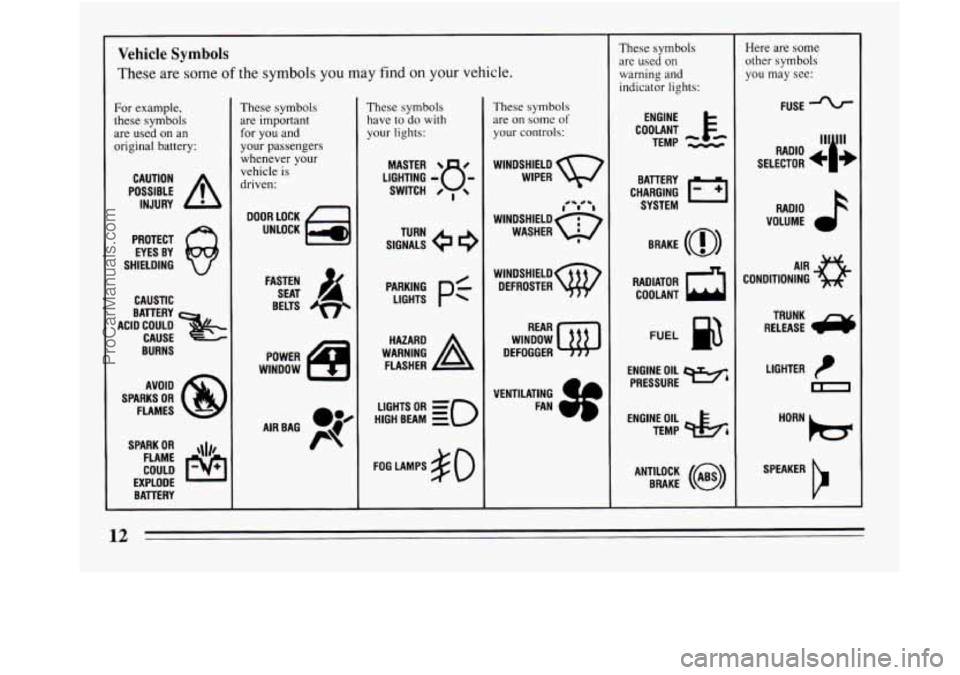
Vehicle Symbols
These are some of the symbols you may find on your vehicle.
For example,
these symbols
are used on an
original battery:
POSSIBLE A
CAUTION
INJURY
PROTECT EYES BY
SHIELDING
CAUSTIC
BURNS AVOID
SPARKS
OR
FLAMES
SPARK OR
,\I/,
FLAME
COULD
EXPLODE
BATTERY
These symbols
are important
for you and
your passengers
whenever your
vehicle is
driven:
DOOR LOCK
UNLOCK
FASTEN SEAT
4
BELTS
POWER
WINDOW
These symbols have
to do with
your lights:
SIGNALS e
TURN
WARNING
A
HAZARD
FLASHER
These symbols are on some
of
your controls:
WINDSHIELD WIPER Q7
WINDOW
DEFOGGER
VENTILATING FAN
HIGH BEAM
=
FOG LAMPS # 0
These symbols
are used
on
warning and
indicator lights:
CHARGING I-1
BATTERY
SYSTEM
RADIATOR COOLANT
FUEL
ENGINE OIL
PRESSURE
Wb
TEMP OIL &
ANTILOCK (a)
BRAKE
Here are some
other symbols
you may see:
FUSE
RADIO
>
VOLUME
CONDITIONING
AIR a
LIGHTER
m
SPEAKER
b
12
ProCarManuals.com
Page 125 of 308
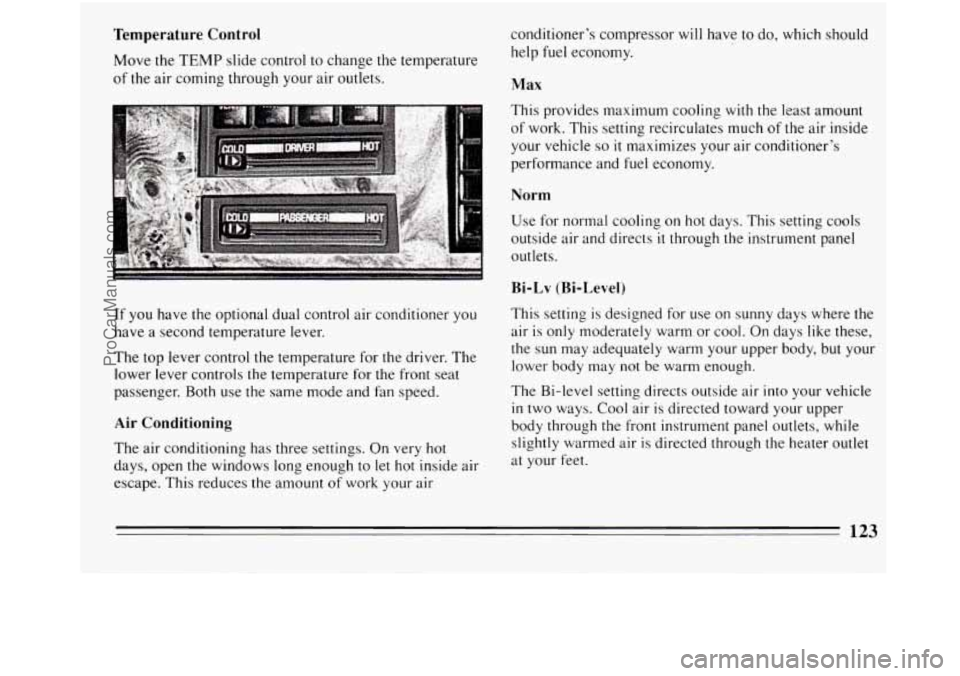
Temperature Control conditioner’s compressor will have to do, which should
Move the TEMP slide control to change the temperature
of the air coming through your air outlets. Max
help fuel economy.
If you have the optional dual control air conditioner you
have a second temperature lever.
The top lever control the temperature for the driver. The
lower lever controls the temperature for the front seat
passenger. Both use the same mode and fan speed.
Air Conditioning
The air conditioning has three settings. On very hot
days, open
the windows long enough to let hot inside air
escape. This reduces the amount of work your
air
This provides maximum cooling with the least amount
of work. This setting recirculates much of the air inside
your vehicle
so it maximizes your air conditioner’s
performance and fuel economy.
Norm
Use for normal cooling on hot days. This setting cools
outside air and directs
it through the instrument panel
outlets.
Bi-Lv (Bi-Level)
This setting is designed for use on sunny days where the
air is only moderately warm or cool.
On days like these,
the sun may adequately warm your upper body, but your
lower body may not be warm enough.
The Bi-level setting directs outside air into your vehicle
in two ways. Cool air is directed toward your upper
body through the front instrument panel outlets, while
slightly warmed air is directed through the heater outlet
at your feet.
123
ProCarManuals.com
Page 126 of 308
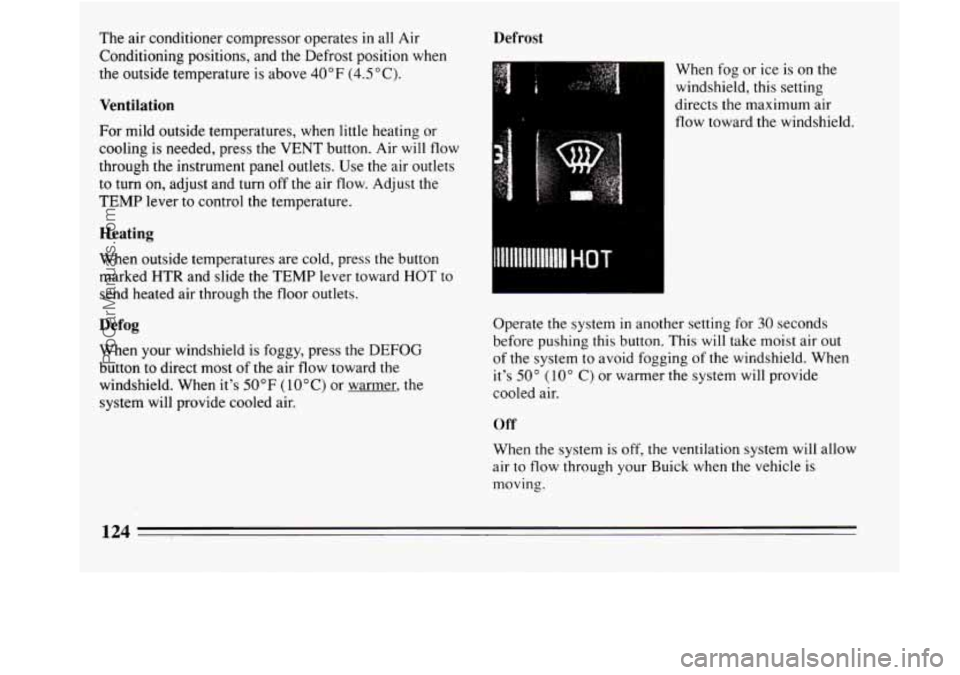
The air conditioner compressor operates in all Air
Conditioning positions, and the Defrost position when
the outside temperature is above
40°F (4.5"C).
Ventilation
For mild outside temperatures, when little heating or
cooling is needed, press the
VENT button. Air will flow
through the instrument panel outlets. Use the air outlets
to turn on, adjust and turn off the air flow. Adjust the
TEMP lever to control the temperature.
Heating
When outside temperatures are cold, press the button
marked HTR and slide the
TEMP lever toward HOT to
send heated air through the floor outlets.
Defog
When your windshield is foggy, press the DEFOG
button to direct most of the air flow toward the
windshield. When it's
50°F (IOOC) or warmer, the
system will provide cooled air.
Defrost
. When fog or ice is on the
windshield, this setting
directs the maximum air
flow toward the windshield.
Operate the system
in another setting for 30 seconds
before pushing this button. This
will take moist air out
of the system to avoid fogging
of the windshield. When
it's 50" (10" C) or warmer the system will provide
cooled air.
Off
When the system is off, the ventilation system will allow
air to flow through your Buick when the vehicle is
moving.
124
ProCarManuals.com
Page 263 of 308
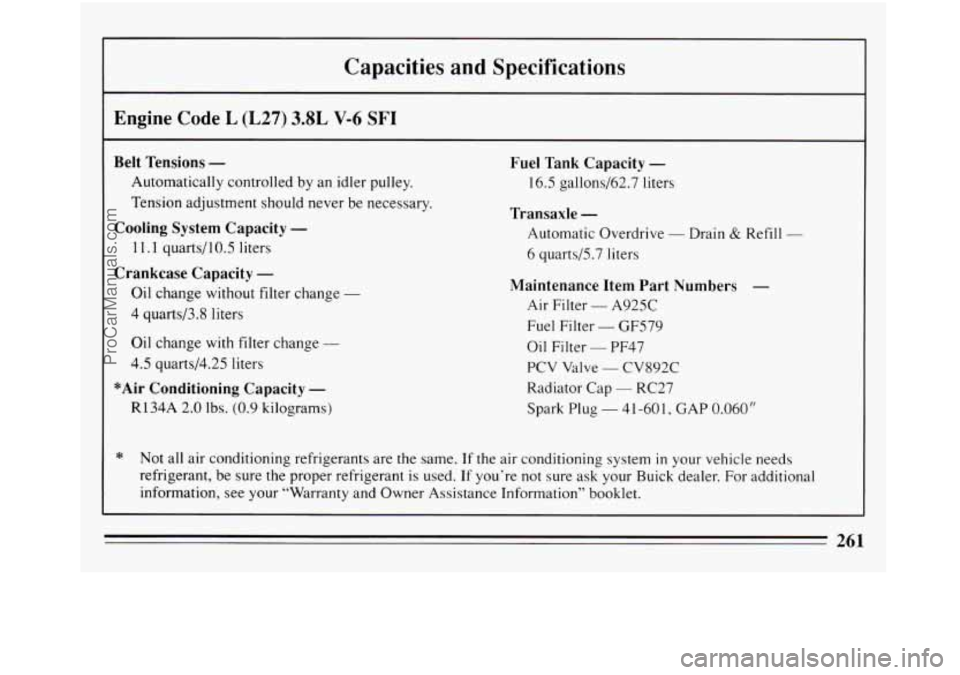
Capacities and Specifications
Engine Code L (L27) 3.8L V-6 SF1
Belt Tensions -
Automatically controlled by an idler pulley.
Tension adjustment should never be necessary.
Cooling System Capacity -
11.1 quartsl10.5 liters
Crankcase Capacity -
Oil change without filter change -
4 quarts/3.8 liters
Oil change with filter change -
4.5 quarts/4.25 liters
*Air Conditioning Capacity -
R134A 2.0 lbs. (0.9 kilograms)
Fuel Tank Capacity -
16.5 gallons/62.7 liters
Transaxle -
Automatic Overdrive - Drain & Refi 11 -
6 quarts/5.7 liters
Maintenance Item Part Numbers -
Air Filter - A925C
Fuel Filter
- GF579
Oil Filter
- PF47
PCV Valve
- CV892C
Radiator Cap
- RC27
Spark Plug
- 4 1-60 1, GAP 0.060”
* Not all air conditioning refrigerants are the same. If the air conditioning system in your vehicle needs
refrigerant, be sure the proper refrigerant is used. If you’re not sure ask your Buick dealer. For additional
information, see your “Warranty and Owner Assistance Information” booklet.
261
ProCarManuals.com
Page 264 of 308
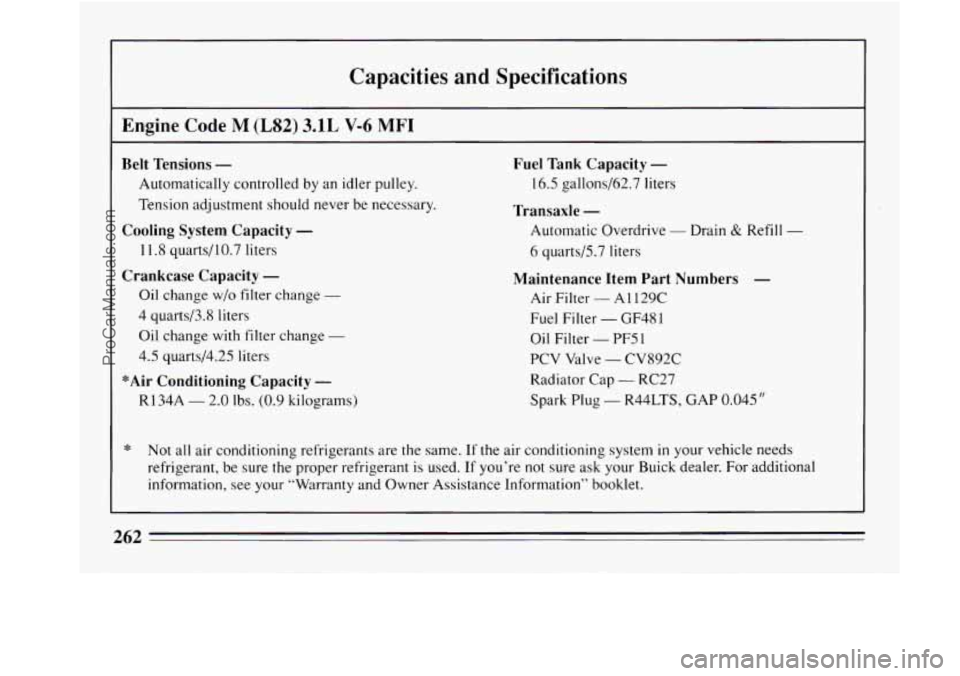
Capacities and Specifications
Engine Code M (LS2) 3.1L V-6 MFI
Belt Tensions -
Automatically controlled by an idler pulley.
Tension adjustment should never be necessary.
Cooling System Capacity -
11.8 quartsll0.7 liters
Crankcase Capacity -
Oil change w/o filter change -
4 quarts/3.8 liters
Oil change with filter change
-
4.5 quarts/4.25 liters
*Air Conditioning Capacity -
R134A - 2.0 lbs. (0.9 kilograms)
Fuel Tank Capacity -
16.5 gallons/62.7 liters
Transaxle -
Automatic Overdrive - Drain & Refill -
6 quarts/5.7 liters
Maintenance Item Part Numbers -
Air Filter - A 1 129C
Fuel Filter - GF48 1
Oil Filter - PF5 1
PCV Valve - CV892C
Radiator Cap
- RC27
Spark Plug
- R44LTS, GAP 0.045”
* Not all air conditioning refrigerants are the same. If the air conditioning system in your vehicle needs
refrigerant, be sure the proper refrigerant is used. If you’re not sure ask your Buick dealer. For additional
information, see your “Warranty and Owner Assistance Information” booklet.
262
ProCarManuals.com
Page 274 of 308
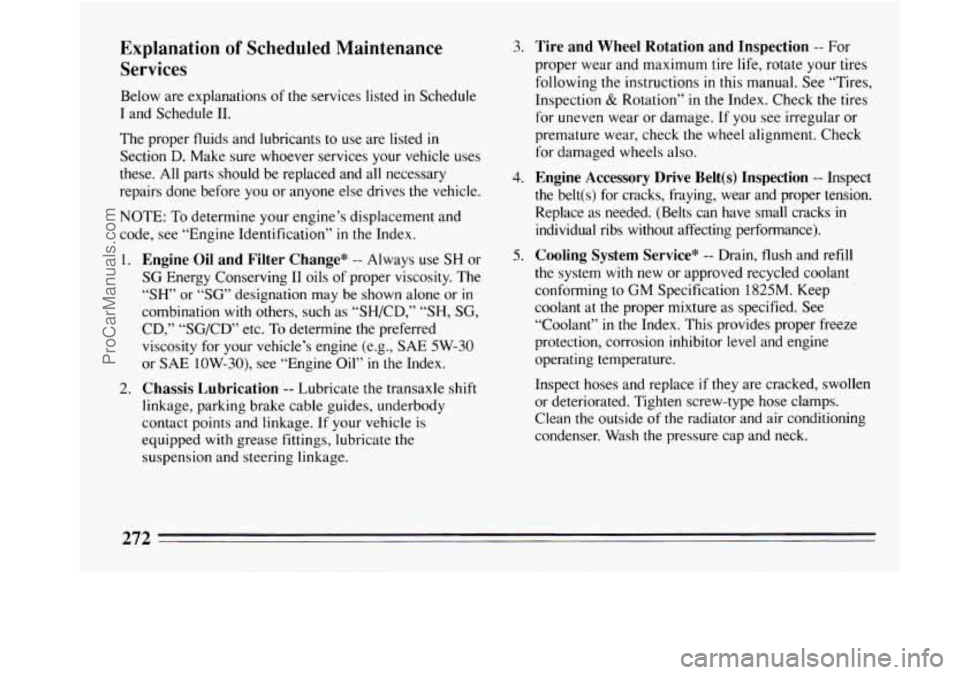
Explanation of Scheduled Maintenance
Services
Below are explanations of the services listed in Schedule
I and Schedule 11.
The proper fluids and lubricants to use are listed
in
Section D. Make sure whoever services your vehicle uses
these. All
parts should be replaced and all necessary
repairs done before you or anyone else drives the vehicle.
NOTE: To determine your engine’s displacement and
code, see “Engine Identification”
in the Index.
1.
Engine Oil and Filter Change* -- Always use SH or
SG Energy Conserving I1 oils of proper viscosity. The
“SH” or “SG” designation may be shown alone or in
combination with others, such as “SH/CD,” “SH, SG,
CD,” “SG/CD” etc.
To determine the preferred
viscosity for your vehicle’s engine (e.g., SAE 5W-30-
or SAE 10W-30), see “Engine Oil” in the Index.
2. Chassis Lubrication -- Lubricate the transaxle shift
linkage, parking brake cable guides, underbody
contact points and linkage. If your vehicle is
equipped with grease fittings, lubricate the
suspension and steering linkage. 3.
4.
5.
Tire
and Wheel Rotation and Inspection -- For
proper wear and maximum tire life, rotate your tires
following the instructions
in this manual. See “Tires,
Inspection
& Rotation” in the Index. Check the tires
for uneven wear or damage. If you see irregular or
premature wear, check the wheel alignment. Check
for damaged wheels also.
Engine Accessory Drive Belt(s) Inspection -- Inspect
the belt(s) for cracks, fraying, wear and proper tension.
Replace as needed. (Belts can have small cracks
in
individual ribs without affecting performance).
Cooling System Service* -- Drain, flush and refill
the system
with new or approved recycled coolant
conforming to GM Specification
1825M. Keep
coolant at the proper mixture as specified. See
“Coolant”
in the Index. This provides proper freeze
protection, corrosion inhibitor level and engine
operating temperature.
Inspect hoses and replace if they are cracked, swollen
or deteriorated. Tighten screw-type hose clamps.
Clean the outside of the radiator and air conditioning
condenser. Wash the pressure cap and neck.
272
ProCarManuals.com